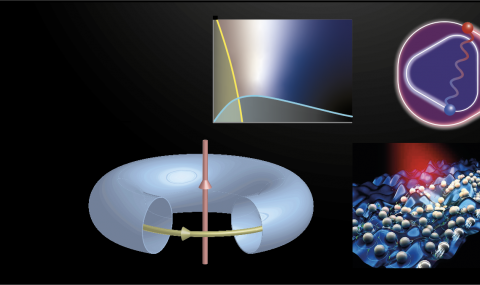Traditionally, different states of matter are classified according to their symmetry: a solid is different from a liquid in that the former breaks the translational and rotational symmetries of space. This principle extends to more exotic states, such as superconductors and superfluids, that spontaneously break the continuous symmetry associated with charge conservation. The success of these principles explains the astonishment of the condensed matter world with the discovery, late in the last century, that many states of matter - especially quantum states at zero temperature - lie beyond this symmetry-based classication. Instead, these states are distinguished by their topological properties. For example, certain quantum Hall states can be characterized by the "anyonic statistics" that their fundamental excitations (quasiparticles) have when they are carried adiabatically around one another. (An "anyon" as an emergent particle whose quantum statics is neither that of a fermion nor a boson.) Superconducting states can also be classified into distinct topological phases, some of which support vortex excitation with anyonic properties.
We have worked on discovering new ways to enrich topological phases such as quantum Hall states by coupling them to superconductors, which can give rise to new types of anyonic "particles" bound to their interface. We have predicted the experimentally detectable properties of these exotic states. Another thrust of our work has been designing new setups for realizing topological superconductivity supporting the Majorana zero modes, desired for their ability to store quantum information in a non-local (and thus protected) way.
Selected Publications:
-
Ari M. Turner, Erez Berg, and Ady Stern, "Gapping fragile topological bands by interactions", Phys. Rev. Lett. 128, 056801 (2022).
-
"Converting electrons into emergent fermions at a superconductor-Kitaev spin liquid interface", Gilad Kishony, Erez Berg, Phys. Rev. B 104, 235118 (2021).
-
"Bulk anyons as edge symmetries: Boundary phase diagrams of topologically ordered states", Tsuf Lichtman, Ryan Thorngren, Netanel H. Lindner, Ady Stern, and Erez Berg, Phys. Rev. B 104, 075141 (2021).
- “Signatures of Topological Superconductivity and Parafermion Zero Modes in Fractional Quantum Hall Edges”, Noam Schiller, Eyal Cornfeld, Erez Berg, Yuval Oreg, Phys. Rev. Research 2, 023296 (2020).
- “Evidence of topological superconductivity in planar Josephson junctions”, Antonio Fornieri, Alexander M. Whiticar, F. Setiawan, Elias Portolés Marín, A. C. C. Drachmann, Anna Keselman, Sergei Gronin, Candice Thomas, Tian Wang, Ray Kallaher, Geof- frey C. Gardner, Erez Berg, Michael J. Manfra, Ady Stern, Charles M. Marcus, Fabrizio Nichele, Nature 569, 89-92 (2019).
- “Fractional Josephson Vortices and Braiding of Majorana Zero Modes in Planar Superconductor-Semiconductor Heterostructures,” Ady Stern and Erez Berg, Phys. Rev. Lett. 122, 107701 (2019).
- “Topological Superconductivity in a Planar Josephson Junction,”Falko Pientka, Anna Keselman, Erez Berg, Amir Yacoby, Ady Stern, Bertrand I. Halperin, Phys. Rev. X 7, 021032 (2017).
- “Signatures of Majorana Zero Modes in Spin-Resolved Current Correlations,” Arbel Haim, Erez Berg, Felix von Oppen, and Yuval Oreg, Phys. Rev. Lett. 114, 166406 (2015).
- “Inducing time reversal invariant topological superconductivity and fermion parity pumping in quantum wires,” Anna Keselman, Liang Fu, Ady Stern, and Erez Berg, Phys. Rev. Lett. 111, 116402 (2013).
- “Fractionalizing Majorana fermions: non-abelian statistics on the edges of abelian quantum Hall states,” Netanel H. Lindner, Erez Berg, Gil Refael, and Ady Stern, Phys. Rev. X 2, 041002 (2012).
- "Topological phases of one-dimensional fermions: An entanglement point of view", Ari M. Turner, Frank Pollmann, and Erez Berg, Phys. Rev. B 83, 075102 (2011).
- “Odd-Parity Topological Superconductors: Theory and Application to CuxBi2Se3,” L. Fu and Erez Berg, Phys. Rev. Lett 105, 097001 (2010).


